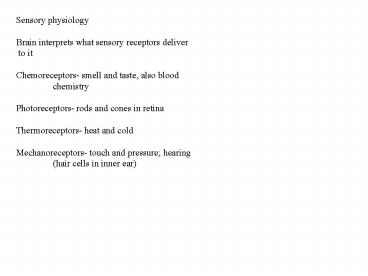Sensory physiology - PowerPoint PPT Presentation
1 / 15
Title:
Sensory physiology
Description:
cutaneous receptors (aka generalized) touch, pressure, pain, heat, cold ... Cutaneous sensations. Different neurons perceive different sensations ... – PowerPoint PPT presentation
Number of Views:782
Avg rating:3.0/5.0
Title: Sensory physiology
1
Sensory physiology Brain interprets what sensory
receptors deliver to it Chemoreceptors- smell
and taste, also blood chemistry Photoreceptors-
rods and cones in retina Thermoreceptors- heat
and cold Mechanoreceptors- touch and pressure
hearing (hair cells in inner ear)
2
Pain receptors (nocireceptors) harder
to stimulate, thankfully Types of pain
receptors proprioreceptors- body position and
movement cutaneous receptors (aka
generalized) touch, pressure, pain, heat,
cold special senses- sight, hearing, taste,
smell
3
Sensory adaptation Phasic receptors- slow down
after initial stimulus adaptation- e.g., odor,
touch, temperature fast-adapting Tonic
receptors- fire at constant rate slow-adapting R
eceptors deliver specific stimulus brain
filters out a lot of the stimuli Produce action
potential in response to stimulus
4
Cutaneous sensations Different neurons perceive
different sensations Free nerve endings- light
touch, temperature, pain Merkels
discs-sustained touch and pressure (superficial)
Ruffinis corpuscles sustained pressure
(deep) Meissners corpuscles- texture, slow
vibration Pacinian corpuscles- deep pressure,
fast vibration
5
(No Transcript)
6
Cold receptors are more numerous and closer to
surface than heat receptors Cold receptors are
inhibited by warming Sharp pain- conducted by
myelinated axons dull pain by unmyelinated
axons Capsaicin receptor- ion channel
produces sensation of pain in response to high
heat
7
Neural pathways to postcentral gyrus Ascending
fibers in dorsal columns of spinal cord Synapse
in medulla oblongata Ascends to
thalamus Sensory neurons project to postcentral
gyrus
8
Receptive fields in skin large if receptors are
few, small if receptors are dense measured by
two-point touch threshold Lateral inhibition-
sensory neurons most strongly affected by a
stimulus inhibit others in nearby receptive
fields
9
(No Transcript)
10
Taste and smell (chemical receptors) tend to
influence each other Taste (gustation) Taste
buds- epithelial cells that act
like neurotransmitters Innervated by cranial
nerves
11
(No Transcript)
12
Four major sensations of taste Sweet- G-protein
activates second messenger system Bitter- also
G-protein activated specific receptor Sour-
proton channel (acids taste sour) Salty- sodium
channels Tastes seem to be enhanced in different
parts of the tongue
13
(No Transcript)
14
Smell (olfaction) receptor cells in olfactory
epithelium sense of smell transmitted directly
to cerebral cortex (all others go
through thalamus) receptors in medial temporal
lobes and in limbic system (emotional response
to odors) Molecular basis for smell is
complex- humans can distinguish up to
10,000 different odors
15
(No Transcript)































